Rick's b.log - 2011/10/09
You are 18.116.20.108, pleased to meet you!
Rick's b.log - 2011/10/09 |
|
| It is the 21st of November 2024 You are 18.116.20.108, pleased to meet you! |
|
mailto: blog -at- heyrick -dot- eu
He makes a perfectly valid point:
I have concerns about the various clauses in GPLv3 which - in the word invented by Mr. Stallman, is anti-tivoisation. This stems from the fact that Tivo use Linux and GPL code in their Tivo box, however they have added a bootloader which only accepts digitally signed binaries. This means a Tivo box running Tivo's software cannot be used with other software. Is this dubious? In the mind of Mr. Stallman, it is. But I am wondering why, now, a software licence is attempting to control what the hardware can and cannot do. Especially in the case where the hardware is a specific fixed-purpose box. Tivo obviously don't want people running random software in their box (especially if such measures lead to a support nightmare). They are selling a "product". So what did Tivo do wrong, exactly? Is Mr. Stallman suggesting that the GPL vision of freedom extends to everything that is even remotely involved with GPL code? That would be nice - I bet large chunks of the closed-source binaries of my PVR were compiled with gcc so let's see the source, bitch.
For more information on the EUPL, visit: http://www.osor.eu/eupl
First up, the digital decoder:
On to the Livebox now. This is somewhat more interesting.
The Livebox itself offers the user:
Perhaps the most bizarre part of the whole device was this fitted to the back of the board:
Instead of being in a town, the event was held in a big dusty field. It's a good thing there was no rain as it would have turned into an epic mud wrestling match (at least I had a camera handy! ☺). There was a lot of stuff, but coming to the end of the season I had very specific things in mind. None of which I found.
The woman wanted a tenner, mom haggled it to five, then just happened to find two €2 coins and... she settled for that.
It goes without saying that a little 'smart' device that needs to get decent time from three AAA cells is going to be an ARM...
Now, perhaps to come as something of a shock, I looked for the river in Negishi where the river bends ever so slightly. I think I've found it. Um...
The second card is a muted photo of a Japanese woman in traditional outfit - a sort of heavy kimono and wooden clogs. So Yune (Ikoku Meiro no Croisée) is not so far from the mark.
Reality, however, was about as different as Negishi above. What we got was some rather lovely tasty carrot slices, but two and a half slices each. Seriously, there were four carrot slices and two 'pieces' in the meal. Rather different from the picture. Likewise, the chicken itself was mostly bone with some rather icky meat attached. The meat was a reddish colour (marinade?) and most of it was hard to eat. Now, I'm not much good at cooking chicken, but I've never come across a chicken piece I couldn't bite with my front teeth. This was only just edible with molars. The bone to meat ratio was pitiful, about twice as much (inedible) bone to meat. Not to mention this must surely have been the scrawniest chicken around.
In short, the only ones interested in the chicken were the cats, and we didn't give it to them because of the grease. The sauce wasn't touched, it - a near €8 "meal for 3/4" (ha ha ha) - was thrown out. It was absolutely disgusting. Except for the carrots. The carrots were nice.
And for the Frenchies:
Free misses the point
Richard Stallman, the great exponent of "free" software wrote a lengthy article about how software being "open source" misses the point. You can read it here.
Maybe "free beer" is an American thing? Anyway, he then lets the side down by repeatedly referring to the GNU/FSF concept as "free software". You know, no matter how many times it is quoted, people's first opinion is going to be "free" as in at no cost. The English language is lacking here, but it could just as easily have been called "freedom software", but it wasn't.
Oh, wait, reality doesn't work like that. Except in GPL land where GPLv3 has been perverted into something less clear, more restrictive, and - frankly - viral. And, if nothing else, these situations - plus the ongoing requirement of making code available - mean the GPL is actually extremely badly suited to commercialised products, in which case stuff specific to the product being commercialised needs to be written from scratch, contain no GPL code, and not be statically linked with any GPL code. Then a company can bring the product to market, distribute the standard GPL kernel/system components, and keep their proprietory intellectual property private. While the GPL is a useful tool (or maybe a weapon) for hacker types such as myself, it is easy to see how this can be seen as highly onerous for commercial enterprise.
This is an interesting point, given the GPL FAQ states (with my emphasis):
This is not free. If I combine software from different copyleft licences, GPL assumes it will be the overriding licence (and anything that makes the same sort of assumption or does not permit relicencing is thus incompatible). This, whether Mr. Stallman likes it or not, is the heart of why GPL is considered by some to be a virus. While Mr. Stallman is correct in saying that the GPL is not virus-like by virtue of inclusion of GPL licenced code is a deliberate action, the fact remains that GPL is only compatible with itself and the more people use GPL, the less code pool exists for those who feel the GPL has fundamental shortcomings.The older GPLv2 was a lot clearer - it reads: "You must cause any work that you distribute or publish, that in whole or in part contains or is derived from the Program or any part thereof, to be licensed as a whole at no charge to all third parties under the terms of this License.
Compare this with a licence that is truly based upon the concept of freedom:
That's part of article 5 of the EUPL. It specifically states, clearly (and for a legalese document, it is a lot clearer than the GPL) that in projects with code from multiple backgrounds, if necessary to satisfy licencing arrangements, EUPL code can be relicenced (that copy, not globally) without consulting the original copyright holder, under the terms of said compatible licence. You can take my EUPL source, combine it with a GPLv2 source, and release the lot under GPLv2. You don't need to ask me for permission, I know that's a factor of the licence and I'm okay with that.
Until the GPL understands this concept, this concept of what freedom is really about, I just don't have time for Mr. Stallman's posturing and his trumpeting about free. The GPL is not free, it just has a lot of fanboys who think that it is. It is interesting to note that GPLv2 is listed as a compatible licence of the EUPL, but GPLv3 is not. This is perhaps because in trying to protect the concept of free & open, GPLv3 is even less permissive. It's a retrograde step. It is not free.
Livebox (old) fiddles
Having finally obtained a set of torx wrenches (like a star hex wrench), I whipped open the digital decoder and the old Livebox.
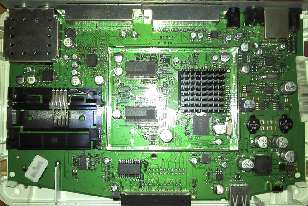
The SoC is unknown, the heatsink is firmly attached. That said, I would be surprised if it was anything other than a member of the ST20 family.
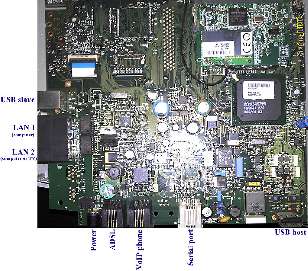
In a nutshell, it is designed to be a mostly complete ADSL router in one chip. As you can see from the picture, there's not a lot besides interfacing logic and buffers, as everything else is in the SoC.
 Two CPU interfaces are provided. The first, CardBus, is apparently present on the board and there are indications where this might be fitted in the plastic casing, however it was never implemented. The second, mini-PCI, is present, fitted, and used as the connection for the WiFi card, as shown.
Two CPU interfaces are provided. The first, CardBus, is apparently present on the board and there are indications where this might be fitted in the plastic casing, however it was never implemented. The second, mini-PCI, is present, fitted, and used as the connection for the WiFi card, as shown.
It is interesting to note the "high tech" solution for the WiFi antennae, two pieces of wire. There is actually some science in the length and angle of these wires. Having two allows for diversity reception, and the 45° angle permits polarisation diversity to be performed as well. Even in a straight line-of-sight situation, there will be a lot of interference from the signal being received being received multiple times, firstly the direct signal, then ones bounced off of walls, floors, etc. The antenna configuration attempts to try to minimise interference by looking at what is received by both antennae.
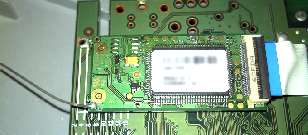
Underneath the label, I can see the controller chip is an ARM powered device by Philips. So I can say, just, that my Livebox has an ARM inside. ☺
One more vide grenier, one more toy
Today's vide grenier was touch and go for the weather - all through the week it was/was not going to rain on Sunday. As it happens, it didn't rain. It started pretty cold, but slowly got warmer.
 I saw a guy selling PS2 games for €2, but it was either football or magical-girls-with-kittens-in-pink-overload. I didn't buy. I did pick up a Livephone.
I saw a guy selling PS2 games for €2, but it was either football or magical-girls-with-kittens-in-pink-overload. I didn't buy. I did pick up a Livephone.
Now a Livephone is an interesting idea. It looks, feels, and works just like a DECT phone, however the radio receiver plugs into the USB port. In this way, encoded audio remains in digital form from the phone processor to the internet. It doesn't need to undergo the distortiond and limitations of the analogue phones. This leads to better quality sound. No more tin-bucket sounds, this is as good as FM radio, with a full frequency response. The only caveat is for full benfit you'd need to call somebody equipped with a similar handset.
One of the batteries was dead, no doubt sitting in the handset 'flat' for far too long. So I took them out and fitted some of my own.
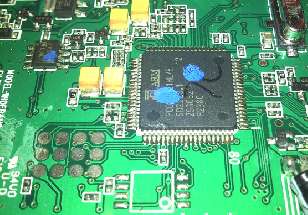
Japanese postcards
At the vide grenier, I was able to find two postcards of Japan. The first, cherry blossom in Negishi, Yokohama:


Not sure what she is doing (is the basket for laundry, harvest, etc?) but she's quite pretty. And very dead - for the date of the message written on the back of the card is 1911. Therefore, this photograph is about a hundred years old:

Maître CoQ - la Poule au Pot - dégoûtant!
The word at the end of the title means disgusting. It smelled nice, so it was bought to help a sort of Sunday roast.
Here's the wrapper:
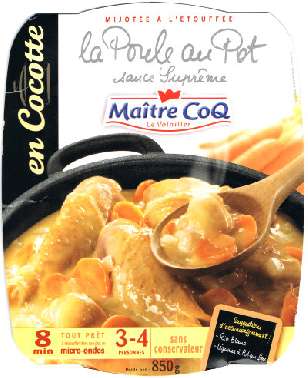
Then there's the sauce. Wow. What can I say? It was a cream-coloured sludge sitting underneath a good centimetre of grease. In fact, for the amount of grease, it is a surprise the chicken was so terrible.
Il semble bien, oui?
I guess you can figure we won't be buying this again... ☺
La réalité, cependant, était près aussi différent que les images de Negishi ci-dessus. Nous avons eu quelques rondelles de carotte plutôt jolie savoureux, mais deux et un demi-rondelles chacune. Sérieusement, il y avait quatre rondelles de carottes et de deux 'morceaux' dans le repas.
Plutôt différent de l'image.
De même, le poulet lui-même était essentiellement avec quelques os et de viande plutôt dégueulasses ci-joint. La viande était d'une couleur rougeâtre (marinade?) et la plupart de qu'il était difficile de manger.
Alors - je ne suis pas très bon à la cuisson du poulet, mais je n'ai jamais rencontré un morceau de poulet je ne pouvais pas la mordrai avec mes dents de devant. Ce viande est comestible seulement avec les molaires.
Le ratio d'os de la viande a été pitoyable, environ deux fois plus d'os (non comestibles) à la viande. Sans parler de cela doit sûrement avoir été la plus maigre poulet autour.
Puis il ya la sauce. Wow. Que puis-je dire? Il était une boue de couleur crème assis sous un bon centimètre de graisse. En fait, pour la quantité de graisse, c'est une surprise que le poulet a été si terrible.
En bref, les seuls intéressés par le poulet étaient les chats, et nous n'avons pas leur donner à cause de la graisse. La sauce n'a pas été touché, il - un repas quasi €8 "pour 3/4 personnes" (ha ha ha) - a été éjecté. Il était absolument dégoûtant. Sauf pour les carottes. Les carottes étaient délicieux.
No comments yet...
| © 2011 Rick Murray |
This web page is licenced for your personal, private, non-commercial use only. No automated processing by advertising systems is permitted. RIPA notice: No consent is given for interception of page transmission. |